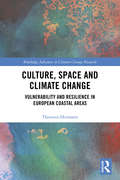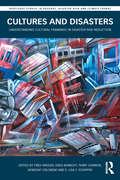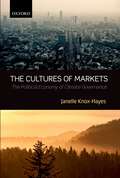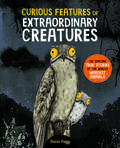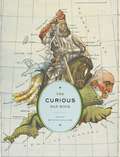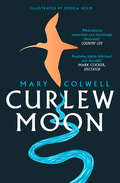- Table View
- List View
Culture, Space and Climate Change: Vulnerability and Resilience in European Coastal Areas (Routledge Advances in Climate Change Research)
by Thorsten HeimannWays of handling climate change vary worldwide. Differences can be observed in the perception of potential threats and opportunities as well as in the appraisal of adequate coping strategies. Collective efforts often fail not because of technical restrictions, but as a result of social and cultural differences between the actors involved. Consequently, there is a need to explore in greater depth those zones of cultural friction which emerge when actors deal with climate change. This book examines how cultural differences in the handling of climate change can be described and explained. The work develops the concept of culture as relational space, elaborates explanatory approaches, and investigates them by surveying more than 800 actors responsible for spatial development of the European coastal regions in the Netherlands, Germany, Denmark, and Poland. In doing so, this book engages with debates on cultural globalisation, in which the attachment of culture to place is increasingly being questioned. Adopting the approach of culture as relational space allows possible cultural formations to be examined across diverse fields of application from the local to the global scale. In addition, the book investigates how far different value orientations, beliefs, and identities can explain diverse perceptions of problems and opportunities right up to preferences for climate-mitigation and adaptation measures. Providing comprehensive insights into the diverse zones of cultural friction which scholars and practitioners face when handling climate change locally and globally, this book will be of great interest to those studying climate change, environmental sociology, and sustainable planning.
Culture, Space and Climate Change: Vulnerability and Resilience in European Coastal Areas (Routledge Advances in Climate Change Research)
by Thorsten HeimannWays of handling climate change vary worldwide. Differences can be observed in the perception of potential threats and opportunities as well as in the appraisal of adequate coping strategies. Collective efforts often fail not because of technical restrictions, but as a result of social and cultural differences between the actors involved. Consequently, there is a need to explore in greater depth those zones of cultural friction which emerge when actors deal with climate change. This book examines how cultural differences in the handling of climate change can be described and explained. The work develops the concept of culture as relational space, elaborates explanatory approaches, and investigates them by surveying more than 800 actors responsible for spatial development of the European coastal regions in the Netherlands, Germany, Denmark, and Poland. In doing so, this book engages with debates on cultural globalisation, in which the attachment of culture to place is increasingly being questioned. Adopting the approach of culture as relational space allows possible cultural formations to be examined across diverse fields of application from the local to the global scale. In addition, the book investigates how far different value orientations, beliefs, and identities can explain diverse perceptions of problems and opportunities right up to preferences for climate-mitigation and adaptation measures. Providing comprehensive insights into the diverse zones of cultural friction which scholars and practitioners face when handling climate change locally and globally, this book will be of great interest to those studying climate change, environmental sociology, and sustainable planning.
Cultures and Disasters: Understanding Cultural Framings in Disaster Risk Reduction (Routledge Studies in Hazards, Disaster Risk and Climate Change)
by Greg Bankoff Terry Cannon Fred Krüger Benedikt Orlowski E. Lisa SchipperWhy did the people of the Zambesi Delta affected by severe flooding return early to their homes or even choose to not evacuate? How is the forced resettlement of small-scale farmers living along the foothills of an active volcano on the Philippines impacting on their day-to-day livelihood routines? Making sense of such questions and observations is only possible by understanding how the decision-making of societies at risk is embedded in culture, and how intervention measures acknowledge, or neglect, cultural settings. The social construction of risk is being given increasing priority in understand how people experience and prioritize hazards in their own lives and how vulnerability can be reduced, and resilience increased, at a local level. Culture and Disasters adopts an interdisciplinary approach to explore this cultural dimension of disaster, with contributions from leading international experts within the field. Section I provides discussion of theoretical considerations and practical research to better understand the important of culture in hazards and disasters. Culture can be interpreted widely with many different perspectives; this enables us to critically consider the cultural boundedness of research itself, as well as the complexities of incorporating various interpretations into DRR. If culture is omitted, related issues of adaptation, coping, intervention, knowledge and power relations cannot be fully grasped. Section II explores what aspects of culture shape resilience? How have people operationalized culture in every day life to establish DRR practice? What constitutes a resilient culture and what role does culture play in a society’s decision making? It is natural for people to seek refuge in tried and trust methods of disaster mitigation, however, culture and belief systems are constantly evolving. How these coping strategies can be introduced into DRR therefore poses a challenging question. Finally, Section III examines the effectiveness of key scientific frameworks for understanding the role of culture in disaster risk reduction and management. DRR includes a range of norms and breaking these through an understanding of cultural will challenge established theoretical and empirical frameworks.
Cultures and Disasters: Understanding Cultural Framings in Disaster Risk Reduction (Routledge Studies in Hazards, Disaster Risk and Climate Change)
by Greg Bankoff Terry Cannon Fred Krüger Benedikt Orlowski E. Lisa SchipperWhy did the people of the Zambesi Delta affected by severe flooding return early to their homes or even choose to not evacuate? How is the forced resettlement of small-scale farmers living along the foothills of an active volcano on the Philippines impacting on their day-to-day livelihood routines? Making sense of such questions and observations is only possible by understanding how the decision-making of societies at risk is embedded in culture, and how intervention measures acknowledge, or neglect, cultural settings. The social construction of risk is being given increasing priority in understand how people experience and prioritize hazards in their own lives and how vulnerability can be reduced, and resilience increased, at a local level. Culture and Disasters adopts an interdisciplinary approach to explore this cultural dimension of disaster, with contributions from leading international experts within the field. Section I provides discussion of theoretical considerations and practical research to better understand the important of culture in hazards and disasters. Culture can be interpreted widely with many different perspectives; this enables us to critically consider the cultural boundedness of research itself, as well as the complexities of incorporating various interpretations into DRR. If culture is omitted, related issues of adaptation, coping, intervention, knowledge and power relations cannot be fully grasped. Section II explores what aspects of culture shape resilience? How have people operationalized culture in every day life to establish DRR practice? What constitutes a resilient culture and what role does culture play in a society’s decision making? It is natural for people to seek refuge in tried and trust methods of disaster mitigation, however, culture and belief systems are constantly evolving. How these coping strategies can be introduced into DRR therefore poses a challenging question. Finally, Section III examines the effectiveness of key scientific frameworks for understanding the role of culture in disaster risk reduction and management. DRR includes a range of norms and breaking these through an understanding of cultural will challenge established theoretical and empirical frameworks.
Cultures of Environmentalism: Empirical Studies in Environmental Sociology
by S. YearleyAs environmental issues increasingly impinge on society, sociologists have turned their attention to nature and the environment. However, unlike the majority of sociological work on environmental issues, which has too often been dominated by abstract theoretical disputes, this book concentrates on empirical studies in environmental sociology. It shows what sociologists can bring to current debates over environmental topics (including genetic modification) and - using the author's first-hand research - demonstrates how sociologists can best pursue practical work on environmental topics.
The Cultures of Markets: The Political Economy of Climate Governance
by Janelle Knox-HayesAnthropogenic climate change poses a grave threat to societies around the world. The greenhouse gases that generate climate change are produced by virtually every sector of every economy. The predominant response of governments around the world is to mitigate climate change through the capping and trading of emissions. This book explores the establishment of emissions trading as a form of environmental, market-based governance in the United States, Europe, Australia, South Korea, Japan, and China. The book conceptualizes markets as institutions, and analyzes them as a system of climate governance. To this end, it argues that international efforts to promulgate markets run up against local cultures of markets that shape economic practices and knowledge to different degrees. While the global agenda under the United Nations Framework Convention on Climate Change has sought to develop similar systems to enable interconnected and synchronized emissions reductions, each of the cases analyzed here has produced different results. The markets and climate policies established reflect the syncretic impact of socio-political and cultural context on the institutional transfer of markets. Each country expresses a varying degree of ease or unease with the establishment of markets as systems of climate governance. Exploration of market adaptation adds new insights to theories of varieties of capitalism. The book also examines the material implications of emissions markets on the environment and climatic systems. In sum, the study finds that cultures of markets present a substantial challenge to a universalist prescription for resolving climate change and highlights issues at the interface of political and economic governance in different political economies. This includes issues of citizen, state, and industry participation, and the materiality of economic and financial productivity.
Cultures of Sustainability and Wellbeing: Theories, Histories and Policies (Routledge Studies in Culture and Sustainable Development)
by Paola Spinozzi Massimiliano MazzantiCultures of Sustainability and Wellbeing: Theories, Histories and Policies examines and assesses the interdependence between sustainability and wellbeing by drawing attention to humans as producers and consumers in a post-human age. Why wellbeing ought to be regarded as essential to sustainable development is explored first from multifocal theoretical perspectives encompassing sociology, literary criticism and socioeconomics, second in relation to institutions and policies, and third with a focus on specific case studies across the world. Wellbeing and its sustainability are defined in terms of biological and cultural diversity; stages of advancement in science and technology; notions of citizenship and agency; geopolitical scenarios and environmental conditions. Wellbeing and sustainability call for enquiries into human capacities in ontological, epistemological and practical terms. A view of sustainability that revolves around material and immaterial wellbeing is based on the assumption that life quality, comfort, happiness, security, safety always posit humans as both recipients and agents. Risk and resilience in contemporary societies define the intrinsically human ability to make and consume, to act and adapt, driving the search for and fruition of wellbeing. How to sustain the dual process of exploitation and regeneration is a task that requires integrated approaches from the sciences and the humanities, jointly tracing a worldwide cartography with clear localisations. This book will be of great interest to students and researchers interested in sustainability through conceptual and empirical approaches including social theory, literary and cultural studies, environmental economics and human ecology, urbanism and cultural geography.
Cultures of Sustainability and Wellbeing: Theories, Histories and Policies (Routledge Studies in Culture and Sustainable Development)
by Paola Spinozzi Massimiliano MazzantiCultures of Sustainability and Wellbeing: Theories, Histories and Policies examines and assesses the interdependence between sustainability and wellbeing by drawing attention to humans as producers and consumers in a post-human age. Why wellbeing ought to be regarded as essential to sustainable development is explored first from multifocal theoretical perspectives encompassing sociology, literary criticism and socioeconomics, second in relation to institutions and policies, and third with a focus on specific case studies across the world. Wellbeing and its sustainability are defined in terms of biological and cultural diversity; stages of advancement in science and technology; notions of citizenship and agency; geopolitical scenarios and environmental conditions. Wellbeing and sustainability call for enquiries into human capacities in ontological, epistemological and practical terms. A view of sustainability that revolves around material and immaterial wellbeing is based on the assumption that life quality, comfort, happiness, security, safety always posit humans as both recipients and agents. Risk and resilience in contemporary societies define the intrinsically human ability to make and consume, to act and adapt, driving the search for and fruition of wellbeing. How to sustain the dual process of exploitation and regeneration is a task that requires integrated approaches from the sciences and the humanities, jointly tracing a worldwide cartography with clear localisations. This book will be of great interest to students and researchers interested in sustainability through conceptual and empirical approaches including social theory, literary and cultural studies, environmental economics and human ecology, urbanism and cultural geography.
Cumulative Effects in Wildlife Management: Impact Mitigation
by Paul R. Krausman Lisa K. HarrisAs humans continue to encroach on wildlands, quality and quantity of wildlife habitat decreases before our eyes. A housing development here, a shopping mall there, a few more trees cut here, another road put in there, each of these diminishes available habitat. Unless the cumulative effects of multiple simultaneous development projects are recogniz
Curating in a Time of Ecological Crisis: Biennales as Agents of Change
by Felicity FennerCurating in a Time of Ecological Crisis reaffirms the relevance and impactful role of art, revealing how contemporary art exhibitions can capture the zeitgeist and advance new and collaborative approaches to a more sustainable inhabitation of Earth. The book is largely focused on biennales, which it argues are the contemporary exhibition models with the greatest capacity to offer new perspectives and propose alternative ways of connecting with our social and natural environments. Felicity Fenner demonstrates this by showing how curators of these high-profile exhibitions are responding in creative and engaging ways to the issues that preoccupy artists and society more broadly, of which the ecological crisis is paramount. Drawing on case studies from different parts of the world, the author reveals how biennales can make a constructive contribution to debates and attitudes around climate change, and how the role of the curator has evolved to re-embrace a duty of care not just to art but to the natural world as well. Curating in a Time of Ecological Crisis investigates how large-scale exhibitions of contemporary international art can become agents of change. As such, the book will be essential reading for scholars, students, and practitioners with an interest in exhibitions, curating, contemporary art, and environmental sustainability.
Curating in a Time of Ecological Crisis: Biennales as Agents of Change
by Felicity FennerCurating in a Time of Ecological Crisis reaffirms the relevance and impactful role of art, revealing how contemporary art exhibitions can capture the zeitgeist and advance new and collaborative approaches to a more sustainable inhabitation of Earth. The book is largely focused on biennales, which it argues are the contemporary exhibition models with the greatest capacity to offer new perspectives and propose alternative ways of connecting with our social and natural environments. Felicity Fenner demonstrates this by showing how curators of these high-profile exhibitions are responding in creative and engaging ways to the issues that preoccupy artists and society more broadly, of which the ecological crisis is paramount. Drawing on case studies from different parts of the world, the author reveals how biennales can make a constructive contribution to debates and attitudes around climate change, and how the role of the curator has evolved to re-embrace a duty of care not just to art but to the natural world as well. Curating in a Time of Ecological Crisis investigates how large-scale exhibitions of contemporary international art can become agents of change. As such, the book will be essential reading for scholars, students, and practitioners with an interest in exhibitions, curating, contemporary art, and environmental sustainability.
Curating the Future: Museums, Communities and Climate Change (Routledge Environmental Humanities)
by Jennifer Newell Libby Robin Kirsten WehnerCurating the Future: Museums, Communities and Climate Change explores the way museums tackle the broad global issue of climate change. It explores the power of real objects and collections to stir hearts and minds, to engage communities affected by change. Museums work through exhibitions, events, and specific collection projects to reach different communities in different ways. The book emphasises the moral responsibilities of museums to address climate change, not just by communicating science but also by enabling people already affected by changes to find their own ways of living with global warming. There are museums of natural history, of art and of social history. The focus of this book is the museum communities, like those in the Pacific, who have to find new ways to express their culture in a new place. The book considers how collections in museums might help future generations stay in touch with their culture, even where they have left their place. It asks what should the people of the present be collecting for museums in a climate-changed future? The book is rich with practical museum experience and detailed projects, as well as critical and philosophical analyses about where a museum can intervene to speak to this great conundrum of our times. Curating the Future is essential reading for all those working in museums and grappling with how to talk about climate change. It also has academic applications in courses of museology and museum studies, cultural studies, heritage studies, digital humanities, design, anthropology, and environmental humanities.
Curating the Future: Museums, Communities and Climate Change (Routledge Environmental Humanities)
by Jennifer Newell Libby Robin Kirsten WehnerCurating the Future: Museums, Communities and Climate Change explores the way museums tackle the broad global issue of climate change. It explores the power of real objects and collections to stir hearts and minds, to engage communities affected by change. Museums work through exhibitions, events, and specific collection projects to reach different communities in different ways. The book emphasises the moral responsibilities of museums to address climate change, not just by communicating science but also by enabling people already affected by changes to find their own ways of living with global warming. There are museums of natural history, of art and of social history. The focus of this book is the museum communities, like those in the Pacific, who have to find new ways to express their culture in a new place. The book considers how collections in museums might help future generations stay in touch with their culture, even where they have left their place. It asks what should the people of the present be collecting for museums in a climate-changed future? The book is rich with practical museum experience and detailed projects, as well as critical and philosophical analyses about where a museum can intervene to speak to this great conundrum of our times. Curating the Future is essential reading for all those working in museums and grappling with how to talk about climate change. It also has academic applications in courses of museology and museum studies, cultural studies, heritage studies, digital humanities, design, anthropology, and environmental humanities.
Curious Features Of Extraordinary Creatures
by Camilla de BedoyereMeet incredible creatures from all around the world in this colourful, fact-packed animal guide.Curious Features of Extraordinary Creatures tells you all the essential facts about some of the most unique mammals, birds, fish, reptiles and insects that can be found on our planet. Bite-sized text breaks down key information about the creature’s appearance, behaviour and habitat, while colourful and dynamic illustrations bring the animal to life in front of you. Each spread also features bold graphic-novel style panels that tell the story of a key aspect of each animal’s daily life, such as the aye-aye foraging for its dinner and the peacock spider performing a dramatic dance to attract a mate.
The Curious Map Book
by Ashley Baynton-WilliamsSince that ancient day when the first human drew a line connecting Point A to Point B, maps have been understood as one of the most essential tools of communication. Despite differences in language, appearance, or culture, maps are universal touchstones in human civilization. Over the centuries, maps have served many varied purposes; far from mere guides for reaching a destination, they are unique artistic forms, aides in planning commercial routes, literary devices for illuminating a story. Accuracy—or inaccuracy—of maps has been the make-or-break factor in countless military battles throughout history. They have graced the walls of homes, bringing prestige and elegance to their owners. They track the mountains, oceans, and stars of our existence. Maps help us make sense of our worlds both real and imaginary—they bring order to the seeming chaos of our surroundings. With The Curious Map Book, Ashley Baynton-Williams gathers an amazing, chronologically ordered variety of cartographic gems, mainly from the vast collection of the British Library. He has unearthed a wide array of the whimsical and fantastic, from maps of board games to political ones, maps of the Holy Land to maps of the human soul. In his illuminating introduction, Baynton-Williams also identifies and expounds upon key themes of map production, peculiar styles, and the commerce and collection of unique maps. This incredible volume offers a wealth of gorgeous illustrations for anyone who is cartographically curious.
The Curious Map Book
by Ashley Baynton-WilliamsSince that ancient day when the first human drew a line connecting Point A to Point B, maps have been understood as one of the most essential tools of communication. Despite differences in language, appearance, or culture, maps are universal touchstones in human civilization. Over the centuries, maps have served many varied purposes; far from mere guides for reaching a destination, they are unique artistic forms, aides in planning commercial routes, literary devices for illuminating a story. Accuracy—or inaccuracy—of maps has been the make-or-break factor in countless military battles throughout history. They have graced the walls of homes, bringing prestige and elegance to their owners. They track the mountains, oceans, and stars of our existence. Maps help us make sense of our worlds both real and imaginary—they bring order to the seeming chaos of our surroundings. With The Curious Map Book, Ashley Baynton-Williams gathers an amazing, chronologically ordered variety of cartographic gems, mainly from the vast collection of the British Library. He has unearthed a wide array of the whimsical and fantastic, from maps of board games to political ones, maps of the Holy Land to maps of the human soul. In his illuminating introduction, Baynton-Williams also identifies and expounds upon key themes of map production, peculiar styles, and the commerce and collection of unique maps. This incredible volume offers a wealth of gorgeous illustrations for anyone who is cartographically curious.
Curlew Moon
by Mary Colwell‘Focuses a razor light on the plight of one of our most iconic birds. Inspirational!’ Tim Birkhead Curlews are Britain’s largest wading bird, known for their evocative calls which embody wild places; they provoke a range of emotions that many have expressed in poetry, art and music.
Current Algebras and Groups (Plenum Monographs in Nonlinear Physics)
by Jouko MickelssonLet M be a smooth manifold and G a Lie group. In this book we shall study infinite-dimensional Lie algebras associated both to the group Map(M, G) of smooth mappings from M to G and to the group of dif feomorphisms of M. In the former case the Lie algebra of the group is the algebra Mg of smooth mappings from M to the Lie algebra gof G. In the latter case the Lie algebra is the algebra Vect M of smooth vector fields on M. However, it turns out that in many applications to field theory and statistical physics one must deal with certain extensions of the above mentioned Lie algebras. In the simplest case M is the unit circle SI, G is a simple finite dimensional Lie group and the central extension of Map( SI, g) is an affine Kac-Moody algebra. The highest weight theory of finite dimensional Lie algebras can be extended to the case of an affine Lie algebra. The important point is that Map(Sl, g) can be split to positive and negative Fourier modes and the finite-dimensional piece g corre sponding to the zero mode.
Current and Future Trends of Rainfall Erosivity and Soil Erosion in Central Asia (SpringerBriefs in Environmental Science)
by Eldiiar Duulatov Xi Chen Gulnura Issanova Rustam Orozbaev Yerbolat Mukanov Amobichukwu C. AmanambuThis book analyses climate change influences on rainfall erosivity and soil erosion across Central Asia, provides an overview (past and projections) on the Central Asian countries where projected changes in rainfall erosivity and erosivity density are the greatest, and discusses the potential impacts on the environment across the region. This analysis is accomplished primarily using the RUSLE model with past and future climate projections, spatiotemporal variations of rainfall erosivity and soil erosion based on WorldClim, and Coupled Model Intercomparison Project Phase 5 (CMIP5) climate models (for Central Asia and separately Kazakhstan). The relationship between precipitation characteristics and erosion has been well established, but spatial and temporal projections of future rainfall erosivity in a changing climate in Central Asia have not been published significantly. Therefore, assessing rainfall erosivity and its consequences can assist specialists and researchers in achieving the best practices for soil conservation. The result of this type of research is all-encompassing, and may reflect normal variations in other parts of the world (for example, the arid and semi-arid regions) and is inherently limited to the Central Asian region.
Current Developments in Atomic, Molecular, and Chemical Physics with Applications
by Man MohanProceedings of an International Conference on Current Developments in Atomic, Molecular, and Chemical Physics with Applications, held March 20-22, 2002, in Delhi, India. The 38 chapters cover a broad range of research activities categorized into four sub-topics, namely: * Processes in Laser Fields, * Chemical Physics, * Collision Processes, * Atomic Structure and Applications.
Current Developments in Bioerosion (Erlangen Earth Conference Series)
by Max Wisshak Leif TapanilaIt has become apparent from the literature that bioerosional processes affect a wide range of biological and geological systems that cross many disciplines among the sciences. This book is dedicated to crossing those traditional disciplinary boundaries to present a united and current perspective on the pattern and process of bioerosion. The book opens with papers on the evolutionary significance of bioerosion. It concludes with a primer on the bioerosion bibliography website.
Current Directions in Ecomusicology: Music, Culture, Nature (Routledge Research in Music)
by Aaron S. Allen Kevin DaweAWARD WINNER OF THE 2018 SOCIETY OF ETHNOMUSICLOGY ELLEN KOSKOFF PRIZE This volume is the first sustained examination of the complex perspectives that comprise ecomusicology—the study of the intersections of music/sound, culture/society, and nature/environment. Twenty-two authors provide a range of theoretical, methodological, and empirical chapters representing disciplines such as anthropology, biology, ecology, environmental studies, ethnomusicology, history, literature, musicology, performance studies, and psychology. They bring their specialized training to bear on interdisciplinary topics, both individually and in collaboration. Emerging from the whole is a view of ecomusicology as a field, a place where many disciplines come together. The topics addressed in this volume—contemporary composers and traditional musics, acoustic ecology and politicized soundscapes, material sustainability and environmental crisis, familiar and unfamiliar sounds, local places and global warming, birds and mice, hearing and listening, biomusic and soundscape ecology, and more—engage with conversations in the various realms of music study as well as in environmental studies and cultural studies. As with any healthy ecosystem, the field of ecomusicology is dynamic, but this edited collection provides a snapshot of it in a formative period. Each chapter is short, designed to be accessible to the nonspecialist, and includes extensive bibliographies; some chapters also provide further materials on a companion website: http://www.ecomusicology.info/cde/. An introduction and interspersed editorial summaries help guide readers through four current directions—ecological, fieldwork, critical, and textual—in the field of ecomusicology.
Current Directions in Ecomusicology: Music, Culture, Nature (Routledge Research in Music)
by Aaron S. Allen Kevin DaweAWARD WINNER OF THE 2018 SOCIETY OF ETHNOMUSICLOGY ELLEN KOSKOFF PRIZE This volume is the first sustained examination of the complex perspectives that comprise ecomusicology—the study of the intersections of music/sound, culture/society, and nature/environment. Twenty-two authors provide a range of theoretical, methodological, and empirical chapters representing disciplines such as anthropology, biology, ecology, environmental studies, ethnomusicology, history, literature, musicology, performance studies, and psychology. They bring their specialized training to bear on interdisciplinary topics, both individually and in collaboration. Emerging from the whole is a view of ecomusicology as a field, a place where many disciplines come together. The topics addressed in this volume—contemporary composers and traditional musics, acoustic ecology and politicized soundscapes, material sustainability and environmental crisis, familiar and unfamiliar sounds, local places and global warming, birds and mice, hearing and listening, biomusic and soundscape ecology, and more—engage with conversations in the various realms of music study as well as in environmental studies and cultural studies. As with any healthy ecosystem, the field of ecomusicology is dynamic, but this edited collection provides a snapshot of it in a formative period. Each chapter is short, designed to be accessible to the nonspecialist, and includes extensive bibliographies; some chapters also provide further materials on a companion website: http://www.ecomusicology.info/cde/. An introduction and interspersed editorial summaries help guide readers through four current directions—ecological, fieldwork, critical, and textual—in the field of ecomusicology.
Current Geotechnical Engineering Aspects of Civil Infrastructures: Proceedings of the 5th GeoChina International Conference 2018 – Civil Infrastructures Confronting Severe Weathers and Climate Changes: From Failure to Sustainability, held on July 23 to 25, 2018 in HangZhou, China (Sustainable Civil Infrastructures)
by Meng-Chia Weng Jeffrey Lee Yong LiuThis book deals with the attempts made by the scholars and engineers to address contemporary issues in geotechnical engineering such as characterization of geomaterials, slope stability and tunneling, sustainability in geohazards and some other geotechnical issues that are becoming quite relevant in today's world. With increasing urbanization rates and development of society, advancement in geotechnical technologies is essential to the construction of infrastructures. Geotechnical Investigation is the first step of applying scientific methods and engineering principles to obtain solutions of civil engineering problems. Papers were selected from the 5th GeoChina International Conference on Civil Infrastructures Confronting Severe Weathers and Climate Changes: From Failure to Sustainability, held on July 23-25, 2018 in HangZhou, China.
Current Global Practices of Corporate Social Responsibility: In the Era of Sustainable Development Goals (CSR, Sustainability, Ethics & Governance)
by Samuel O. IdowuThis book addresses the status quo of Corporate Social Responsibility practices and their development since 2008. How have things changed in the practice of CSR? What new opportunities and challenges have arisen? The book reports on an international set of cases and case studies on how CSR is practiced at business and organizations in various countries. It analyzes country-specific and industry-specific issues, as well as general global issues in connection with the United Nations’ Sustainable Development Goals. The contributions gathered here provide comprehensive information on CSR for both practitioners and researchers around the globe.
